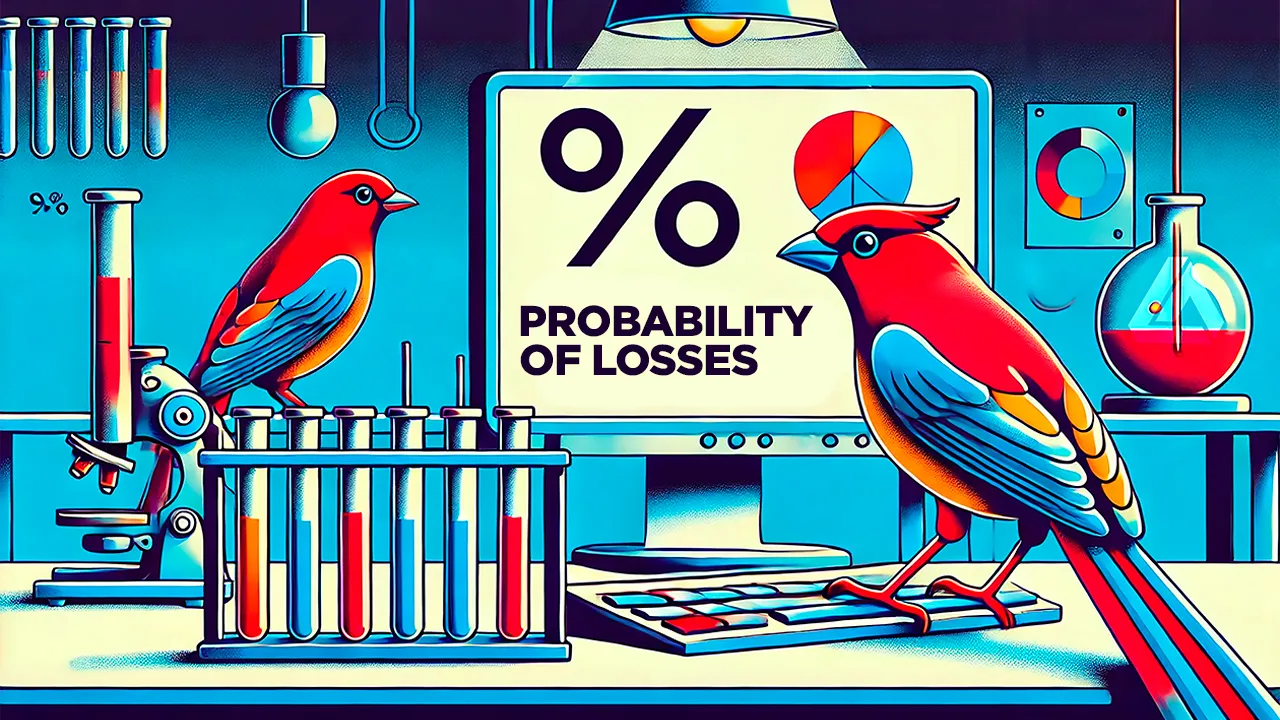INTRODUCTION
Losses are a given in the trading business. Even the most seasoned traders occasionally place losing bets, and it happens frequently for these losses to happen one after the other. For every trader who wants to efficiently manage risk and stick to a consistent trading strategy, knowing the likelihood of making a string of losing trades is essential. This blog explores the possibility of having a string of losses in transactions, we'll look at how various win rates affect these odds and offer advice on how to modify your risk tolerance to handle these difficult situations more skilfully.
Understanding Consecutive Losing Trades
It's critical to understand the concept of repeated failed trades and their significance before going into the numbers. Every trade you make has a chance of being profitable or losing money. But since results aren't always distributed equally, winning and losing streaks can occur when wins and losses group together. This becomes especially significant when one considers the effects on traders' finances and mental health. A run of losses might cause a trader to lose confidence, which may cause them to act impulsively and depart from a well-thought-out plan. Financially speaking, a series of losses can swiftly reduce an account's equity, particularly if risk factors are not appropriately controlled.
A key factor in understanding the probability of consecutive losing trades is the trader’s win rate. The win rate is simply the percentage of trades that result in a profit. For example, if you win thirty out of fifty trades, your win rate is sixty percent. However, determining an accurate win rate requires more than just a small handful of trades. The concept of sample size is crucial here. A larger sample size gives you a more reliable estimate of your win rate, reducing the influence of short-term fluctuations. For instance, if you’ve only completed ten trades, your win rate could be skewed by a few lucky wins or unlucky losses. But with a sample size of fifty or more trades, you begin to get a clearer picture of your true win rate.
For most traders, a sample size of at least one hundred trades is recommended to accurately gauge their win rate. This ensures that the win rate is not overly influenced by short-term market conditions or anomalies and provides a solid foundation for calculating the probabilities of experiencing consecutive losses. Understanding your win rate is critical because it directly impacts the likelihood of encountering losing streaks. For example, a trader with a fifty percent win rate has a different risk profile compared to one with a seventy-five percent win rate. By analyzing these probabilities, traders can better prepare for the inevitable losing streaks, ensuring they maintain both their capital and their composure.
To help traders understand and anticipate the probability of experiencing a specific number of consecutive losses, we utilize a probability table. This table takes into account the trader’s win rate—the percentage of trades that are winners—and calculates the likelihood of encountering losing streaks of various lengths within a sample of fifty trades.

For instance, a trader with a 50% win rate has a different risk profile compared to one with a 75% win rate. By analyzing these probabilities, traders can better prepare for the inevitable losing streaks, ensuring they maintain both their capital and their composure.
The Probability Table: A Closer Look
Now that we have a solid understanding of win rates and their importance, let’s turn our attention to the probability table. This table is an essential tool for visualizing the likelihood of encountering consecutive losing trades within a sample of fifty trades. Each row of the table represents a different win rate, ranging from five percent to ninety-five percent, and each column represents the probability of encountering at least a certain number of consecutive losses, from two to eleven.

Reading the Table
To effectively use this table, start by identifying your win rate in the leftmost column. From there, move across the row to see the probabilities of experiencing at least two, three, four, and more consecutive losing trades. For instance, if your win rate is fifty percent, you can see there is a one hundred percent chance of encountering at least two consecutive losing trades, a ninety-nine percent chance of experiencing at least three, and a twenty nine percent chance of hitting seven consecutive losses within a sample of fifty trades.

Insights and Implications
This table sheds important light on the characteristics of trading risks. For instance, traders who have smaller win rates are far more prone to go through protracted losing streaks. There is a 97% probability of experiencing at least five consecutive losing trades if your win percentage is 50%. Conversely, traders who have greater win rates, let's say seventy percent, are significantly less likely to experience these kinds of streaks.
Even traders with a strong win percentage are susceptible to losing streaks; they are more likely than not. This realisation emphasises how crucial it is to have effective risk management techniques as, even with a high win percentage, you can still run the danger of suffering repeated losses.
Using the Table for Risk Management
The probability table should serve as a guide for setting realistic expectations and preparing for worst-case scenarios. If the table shows that you have a high probability of encountering a certain number of consecutive losses, it would be wise to adjust your risk parameters accordingly. This might include reducing your position size, setting stricter stop-loss levels, or diversifying your trades to mitigate the impact of a losing streak.
For instance, if your win rate is fifty percent, and you see that there’s a seventy-one percent chance of encountering six consecutive losses, you might decide to risk a smaller percentage of your capital per trade to ensure that such a streak does not wipe out a significant portion of your account.
Strategies for Adjusting Risk Parameters
Knowing how likely it is to lose deals in a row is only the first step. The true benefit is when you use this information to adjust your trading approach. You can make sure that you're trading with a strategy intended for long-term success and better safeguard your capital during unavoidable losing streaks by modifying your risk parameters.
1. Position Sizing
One of the most effective ways to manage risk is by adjusting your position size. Position sizing determines how much of your capital you risk on each trade. If the probability table indicates a high likelihood of encountering multiple consecutive losses, you might want to reduce the amount of capital you risk per trade. For instance, instead of risking two percent of your account per trade, you might decide to risk one percent or even less, especially when the chances of encountering a losing streak are high.
2. Stop-Loss Adjustments
Another key aspect of risk management is setting appropriate stop-loss levels. A stop-loss order automatically closes a trade when the price reaches a certain level, limiting the trader’s losses. Based on the probability table, you might consider tightening your stop-loss levels if you expect a losing streak, to prevent small losses from escalating into more significant drawdowns. Alternatively, you could opt for a more conservative strategy by placing wider stop-losses but with smaller position sizes, allowing the trade more room to breathe while still controlling overall risk.
3. Diversification
Diversification is a strategy that involves spreading your trades across different assets, sectors, or even trading strategies. By not putting all your eggs in one basket, you reduce the impact of a losing streak in any single area. If the probability table shows a high chance of consecutive losses, diversifying your trades can help cushion the blow. For example, if you’re trading multiple currency pairs or stocks, ensure that these assets are not highly correlated, so a losing streak in one doesn’t necessarily mean a losing streak in another.
5. Reviewing and Adapting Your Strategy
Finally, it’s crucial to regularly review your trading strategy in light of the probabilities you’ve learned. If your strategy is experiencing losing streaks that align with the probabilities in the table, consider whether the strategy needs to be adjusted. This might involve tweaking entry and exit rules, reconsidering risk-reward ratios, or even pausing trading during certain market conditions. Continuous adaptation is key to staying ahead in the markets.bWith these strategies, traders can better manage the risks associated with consecutive losing trades. By applying insights from the probability table, you can fine-tune your approach to trading, ensuring that your capital is protected and your mindset remains resilient, even during challenging periods.
Final Remarks
The probability table we explored in this blog serves as a valuable tool for setting realistic expectations and managing risk. It reveals that even traders with strong win rates are not immune to losing streaks and that these streaks can occur more frequently than one might expect. Armed with this knowledge, you can implement strategic adjustments such as optimizing position sizes, setting appropriate stop-loss levels, diversifying your trades, and preparing mentally for the ups and downs of the market. Understand that trading is a marathon rather than a sprint. Long-term survival and growth is the aim, and this calls for a methodical approach to risk management. You'll be more prepared to endure the inevitable loss streaks and maintain your trading account if you apply these insights to your daily trading practice.
References
(1) FTMO Blog on Luck in Trading - https://ftmo.com/en/luck-in-trading/








